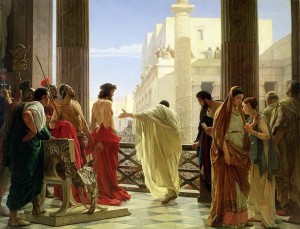
When you set out to comment on a centuries-old document, sometimes your topic is at the heart of your passions. Sometimes, not so much.
You just have to deal with each bit, even if it is outside the range of your interests. Or your confidence. Or whatever.
I know this: I’ve been blogging my way through the Heidelberg Catechism for about three years. It is a 450 year old summary of biblical Christianity. There are 129 questions, and it covers the whole shebang.
I have a few dozen questions left. It seems I’ve done a bit of cherry picking.
I suspect at times that the writers of the Catechism found themselves in the same situation.
Among other things, they committed themselves to explain every single line of the Apostles’ Creed, a doctrinal summary whose roots went back over 1000 years when the Catechism got hold of it.
Some stuff they are passionate and articulate about.
At some points their interest seems to flag.
For instance, when the Catechism notes that Jesus suffered “under Pontius Pilate,” here’s what it says:
38 Q. Why did he suffer “under Pontius Pilate” as judge?
A. So that he,
though innocent,
might be condemned by an earthly judge,
and so free us
from the severe judgment of God that was to fall on us.
Why does the Creed say this? Why point out that he suffered under Pontius Pilate?
Off the top of my head I can think of a few pretty good answers:
- The Creed notes that he “suffered” to remind us that Jesus lived a truly human life; he was not an apparition of some sort as certain heretical groups said.
- The Creed names “Pontius Pilate” to remind us that Jesus really lived at a particular point in history; he was not made up.
- The Creed names the Roman governor as his judge to keep us from the common anti-semitic idea of blaming the Jews for Jesus’ death.
But the Catechism goes instead with a rather poetic parallel:
The condemnation of divine Jesus by human Pilate
frees human us from divine condemnation.
It is like the parallelisms you find throughout the Psalms
It is like the typological echoes you find in New Testament references to the Old
- between the OT Melchizedek and Christ as High priest
- Between the OT sanctuary and the place of God in heaven
- Between Adam, the source of sin, and Christ, the source of salvation
And it is like the traditional parallels drawn between “womb” and “tomb”: Mary’s womb that gave birth to the infant Jesus, and the tomb from which he emerged in resurrection.
Of course it is also an expression of substitutionary atonement.
I have to say, though, that I’m more drawn to this kind of substitution idea when it comes as poetry than as rationalistic speculation about the divine system of justice.
————
Looking for a way to engage with Scripture over the long haul, letting the Bible form your faith and discipleship? Let me send you a free copy of my new book, Love Your Bible: Finding Your Way to the Presence of God with a 12th Century Monk.

Leave a Reply